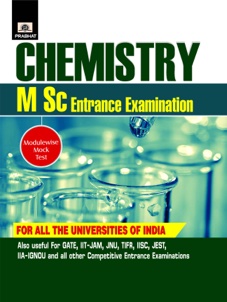
CONTENTS
Preface —Pgs. iii
Joint Admission Test for M Sc (JAM) —Pgs. v
PART ONE: INORGANIC CHEMISTRY
MODULE I
1. Periodic Table —Pgs. 5
1.1 Dobereiner’s Triads —Pgs. 5
1.2 Newland’s Law of Octaves (1864) —Pgs. 5
1.3 Mendeleev’s Periodic Table —Pgs. 5
1.4 Modern Periodic Table —Pgs. 7
1.5 Classification of Elements on the basis of their Electronic Configuration —Pgs. 7
2. Chemical Bonding and Shapes of Compounds —Pgs. 26
2.1 Chemical Bonding —Pgs. 26
2.2 Hybridization —Pgs. 29
2.3 Vsepr Theory —Pgs. 31
2.4 Molecular Orbital (MO) Theory —Pgs. 32
2.5 Hydrogen Bond —Pgs. 34
3. Main Group Elements s- and p- Blocks —Pgs. 52
3.1 Main Group Elements —Pgs. 52
3.2 Alkali Metals —Pgs. 52
3.3 Extraction of Lithium —Pgs. 58
3.4 Extraction of Sodium —Pgs. 60
3.5 Compounds of Alkali Metals —Pgs. 61
3.6 Alkaline Earth Metals —Pgs. 65
3.7 Extraction of Magnesium —Pgs. 73
3.8 Compounds of Alkaline Earth Metals —Pgs. 74
3.9 Some Important Properties of p-Block —Pgs. 78
3.10 Extraction of Aluminium —Pgs. 80
3.11 Carbon Family —Pgs. 81
4. Transition Elements d- and f- Blocks —Pgs. 99
4.1 Transition Elements —Pgs. 99
4.2 Study of Some Important Compounds —Pgs. 100
4.3 f-Block Elements —Pgs. 104
4.4 Metallurgy —Pgs. 106
Mock Test Module I —Pgs. 122
MODULE II
5. Bioinorganic Chemistry —Pgs. 131
5.1 Bioinorganic Chemistry —Pgs. 131
5.2 Metalloporphyrins —Pgs. 132
6. Instrumental Methods of Analysis —Pgs. 140
6.1 Instrumental Methods of Analysis —Pgs. 140
6.2 Environmental Chemistry —Pgs. 140
6.3 Pollution —Pgs. 144
7. Analytical Chemistry —Pgs. 154
7.1 Analytical Chemistry —Pgs. 154
7.2 Functions of Analytical Chemistry —Pgs. 154
7.3 Titration —Pgs. 154
7.4 Acid-Base Theories —Pgs. 156
7.5 Solubility —Pgs. 164
7.6 Compleximetry —Pgs. 169
7.7 Redox —Pgs. 172
7.8 Qualitative Analysis —Pgs. 176
Mock Test Module II —Pgs. 217
PART TWO: ORGANIC CHEMISTRY
MODULE I
1. Basic Concepts of Organic Chemistry and Stereochemistry —Pgs. 5
1.1 Basic Concepts in Organic Chemistry —Pgs. 5
1.2 Resonance and Mesomeric Effect —Pgs. 8
1.3 Hyperconjugation —Pgs. 10
1.4 Types of Organic Reactions —Pgs. 11
1.5 Nomenclature —Pgs. 14
1.6 Isomerism —Pgs. 22
1.7 Hydrocarbons —Pgs. 31
1.8 Alkane or Paraffins —Pgs. 34
1.9 Alkenes or Olefins —Pgs. 36
1.10 Alkynes —Pgs. 40
2. Organic Reaction Mechanism and Synthetic Applications —Pgs. 89
2.1 Condensation Reaction —Pgs. 89
2.2 Reduction and Other Reactions —Pgs. 92
2.3 Cannizzaro Reaction —Pgs. 93
2.4 Claissen-Schmidt Reaction or Condensation —Pgs. 94
2.5 Some More Important Reactions —Pgs. 97
2.6 Diel’s Alder Reaction —Pgs. 102
2.7 Friedal-Craft Alkylation and Actylation —Pgs. 103
2.8 Some More Synthesis Reactions —Pgs. 106
2.9 Harrise Ozonolysis Reaction —Pgs. 110
2.10 Some More Reactions —Pgs. 111
2.11 Aromatic Conversions Involving Two Steps —Pgs. 140
2.12 Aromatic Conversions Involving Three Steps —Pgs. 141
2.13 Some Multistep Aromatic Conversions —Pgs. 143
2.14 Some Mixed Conversions —Pgs. 144
Mock Test Module I —Pgs. 160
MODULE II
3. Qualitative Organic Analysis —Pgs. 173
3.1 UV, Visible and IR Spectroscopy —Pgs. 173
3.2 NMR Spectroscopy —Pgs. 175
4. Natural Products Chemistry —Pgs. 188
4.1 Biomolecules —Pgs. 188
4.2 Biotechnology —Pgs. 196
5. Aromatic and Heterocyclic Chemistry —Pgs. 207
5.1 Aromatic Chemistry —Pgs. 207
5.2 Aromatic Hydrocarbons —Pgs. 208
5.3 Benzene —Pgs. 209
5.4 Toluene —Pgs. 212
Mock Test Module II —Pgs. 229
PART THREE: PHYSICAL CHEMISTRY
MODULE I
1. Basic Mathematical Concepts —Pgs. 5
1.1 Basic Mathematical Concepts —Pgs. 5
1.2 Trigonometric Function —Pgs. 5
1.3 Function —Pgs. 7
1.4 Differentiation —Pgs. 7
1.5 Integral of A Function —Pgs. 14
1.6 Calculus in One-dimensional Motion —Pgs. 17
1.7 Determinant —Pgs. 19
1.8 Statistics —Pgs. 23
1.9 Correlation —Pgs. 35
1.10 Regression —Pgs. 37
1.11 Probability —Pgs. 42
2. Atomic and Molecular Structure —Pgs. 57
2.1 Structure of Atom —Pgs. 57
2.2 X-rays —Pgs. 61
3. Theory of Gasses —Pgs. 83
3.1 Theory of Gasses —Pgs. 83
3.2 Energy Distribution in Gases —Pgs. 84
3.3 Applications of KTG —Pgs. 86
4. Solid State —Pgs. 110
4.1 Solid State —Pgs. 110
4.2 Lattices Symmetry —Pgs. 110
4.3 Electronic Imperfections —Pgs. 113
4.4 Properties of Solids —Pgs. 114
5. Chemical Thermodynamics —Pgs. 138
5.1 Thermometry —Pgs. 138
5.2 Laws of Thermodynamics —Pgs. 140
5.3 Thermochemistry —Pgs. 142
Mock Test Module I —Pgs. 172
MODULE II
6. Chemical and Phase Equilibria —Pgs. 185
6.1 Equilibrium —Pgs. 185
6.2 Chemical Equilibrium —Pgs. 186
6.3 Le Chatelier’s Principle and Applications —Pgs. 188
6.4 Ionic Equilibrium —Pgs. 190
6.5 Acid and Base —Pgs. 192
6.6 Phase Equilibrium —Pgs. 200
7. Electrochemistry —Pgs. 236
7.1 Electrolysis —Pgs. 236
7.2 Faraday’s Law of Electrolysis —Pgs. 237
7.3 Conductance —Pgs. 237
7.4 Electrochemical Cells —Pgs. 239
7.5 Polarization —Pgs. 242
8. Chemical Kinetics —Pgs. 265
8.1 Chemical Kinetics —Pgs. 265
8.2 Rate of Reaction —Pgs. 266
8.3 Reactions of Various Orders —Pgs. 268
8.4 Theories of Reaction Rate —Pgs. 270
8.5 Mechanism of The Reaction —Pgs. 273
8.6 Photochemical Reaction —Pgs. 273
8.7 Catalysis —Pgs. 274
9. Adsorption —Pgs. 296
9.1 Adsorption —Pgs. 296
9.2 Adsorption Isotherms —Pgs. 297
9.3 Catalysis —Pgs. 298
9.4 Colloidal State —Pgs. 300
10. Spectroscopy —Pgs. 317
10.1 Ultraviolet and Visible Spectroscopy —Pgs. 317
10.2 Infrared Spectroscopy —Pgs. 319
10.3 NMR Spectrum —Pgs. 322
Mock Test Module II —Pgs. 333
MOCK TEST CHEMISTRY —Pgs. 1